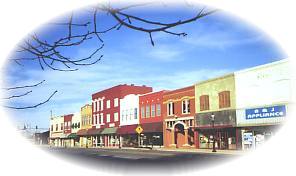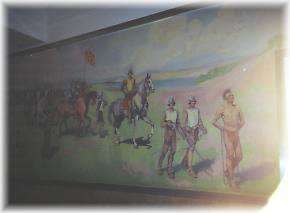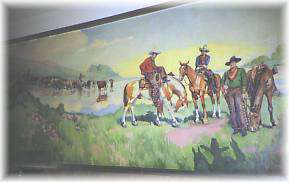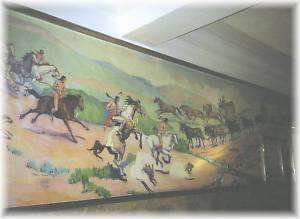
Ruth Monro Augur, nationally known muralist, was forced on W.P.A. rolls during the depression because her commissions fell off so badly. She worked for $57.50 a month while painting the murals in the Garfield County Courthouse in Enid, Oklahoma.
She officially began on December 1, 1935, and estimated that she spent the equivalent of 15 to 16 months in research in the three year project in order to capture every historic detail of a land and a people that no longer existed except in the history books and the minds of a few old settlers.
The six murals cover 1,136 square feet and contain 36 pounds of white paint and 20 pounds of combined colors. The oil paints that were used were manufactured from a single chemical base, regardless of color. This was done in order to avoid fading and discoloration of the murals in years to come, and according to Miss Augur, the colors will be as bright 200 years from now, as they are today.
Upon entering the WEST ENTRANCE -
"Explorer's Trail" (South wall) - Presents General Francisco Vasquez de Coronado and his expedition crossing the Cherokee Strip area in June, 1541. They were the first white men to enter this region, and in the name of Spain, claimed all of what is now Arizona, New Mexico, Texas, Oklahoma, Kansas, and Colorado. Coronado brought the first horses to the plains area. The Indians, at first, thought man and horse one being, but it was not long until it became the dominating ambition of every Indian to possess one.
"The Hunting Trail" (North wall) - Indian Stalking Buffalo, this mural shows the hunting methods of the Indians previous to the advent of white men and horses to the plains.
At the EAST ENTRANCE -
"The Cattle Trail" (North wall) - The scene is Government Springs Park before the Cherokee Strip was opened for settlement. It shows a herd of about 6,000 cattle at the water hole in the Chisholm Trail, a favorite camping place for all trail outfits. The year of 1866 began the great northern drives of the Texas herds to the Kansas railroad points, which continued for twenty years.
"Commerce Trail" (South wall) - Shows the transportation medium used before railroads were built through the Cherokee Strip. "Bull-whackers," tough hombres who could flick a fly with the point of a twelve foot blacksnake whip, drove the slow moving ox-teams that pulled loads up to 3 tons. Mules were all handled by "mule-skinners," picturesque characters, who were specialists in mule psychology and in profanity understandable to mules. The stage coaches carried the passengers, mail and express, using fast horses that were changed at relay stations along the route, every ten miles.
built through the Cherokee Strip. "Bull-whackers," tough hombres who could flick a fly with the point of a twelve foot blacksnake whip, drove the slow moving ox-teams that pulled loads up to 3 tons. Mules were all handled by "mule-skinners," picturesque characters, who were specialists in mule psychology and in profanity understandable to mules. The stage coaches carried the passengers, mail and express, using fast horses that were changed at relay stations along the route, every ten miles.
ASCENDING THE STAIRS -
"The Home-Seeker's Trail" - Shows the start of the land run for the opening of the Cherokee Strip, 1893.
"The Rancher's Trail" - Shows roping and branding cattle. Every minute detail in this mural and all the other murals is completely authentic - cattle trails, wagon trains, branding scenes, buffalo, clothing and frontier implements.
